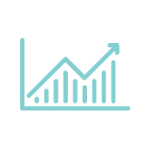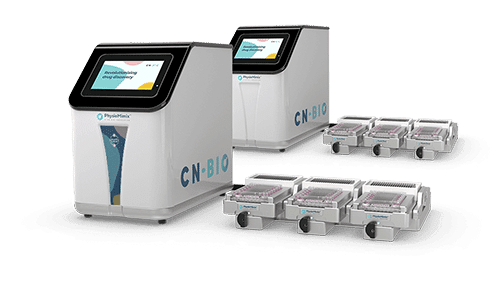Speak to an expert about NASH-in-a-box
PhysioMimix® consumables
NASH-in-a-box
Fast-track your route to successful therapeutic development with our in vitro 3D NASH model

NASH-in-a-box contains everything required to recreate our industry-validated human in vitro Non-Alcoholic Steatohepatitis (NASH) model in your own laboratory.
It is designed for use with our PhysioMimix OOC range of single- and multi-organ microphysiological systems.
Watch the short animation (look right) which describes how our NASH-in-a-box kit enhances your chance of successfully developing NASH therapeutics by recreating our industry-proven 3D NASH model in your laboratory.
NASH-in-a-box supports:

The rapid adoption of an organ-on-a-chip approach by scientists, irrespective of their experience

Instant access to validated protocols developed and refined through years of industry collaboration

Generation of high-content clinically translatable data to unlock disease mechanisms and confirm drug efficacy and safety
Features of our 3D NASH model kit
Use NASH-in-a-box to address the limitations of traditional approaches and avoid unexpected results in the clinic.
- PhysioMimix OOC compatible and fully supported
- Software-guided protocols
- 3D validated primary human hepatocytes, stellate, and Kupffer cells
- Proprietary NASH media and supplements
- ELISA quality control kits (albumin/cytotoxicity) to test microtissue health and function
- Guaranteed for 14 days of culture
- 10-month shelf life (from manufacture)
*Some geographical regions may have legislation for storing human cells requiring a license.

Cells sourced from LifeNetHealth LifeSciences or Lonza

NASH-in-a-box Animated Video
What’s in the box?
Media
| Media | Volume |
| Hepatocyte thawing media | 50 mL |
| Basal media (HEP-Fat) | 500 mL |
| Basal media (HEP-Stellate) | 250 mL |
| Basal media (HEP-Seeding) | 250mL |
Assay kits
| Quality control assays | Number of kits |
| Assaypro Human Albumin AssayMax ELISA Kit | 2 kits |
| Promega CytoTox 96 Cytotoxicity (LDH) Assay Kit | 1 kit |
PhysioMimix plates
| Multi-chip plates | Number of plates/replicates |
| Multi-chip Liver-12+ plate (MPS-LC12+) | 2 plates /24 replicates |
Supplements
| Supplements | Volume |
| HEP- Supplement A | 5 x 2.5 mL |
| HEP Supplement B | 1 x 250 µL |
| HEP- Supplement C | 1 x 500 µL |
| HEP- Supplement D | 1 x 500 µL |
| Hydrocortisone | 5 x 5 µL |
| TGF – Beta | 5 x 200 µL |
Primary human cells
| Primary human cells* | Number of cells |
| Hepatocytes | min 10M |
| Kupffer cells | min 1M |
| Stellate cells | min 100K |
*Contact us should you require specific donor characteristics or pooled donors.
Validation report
Our sample report describes the extensive process of validating donor cell combinations within NASH-in-a-box.
Our quality control procedures ensure the formation of stable three-dimensional liver microtissues that demonstrate a NASH phenotype when cultured over 14 days.
Guided software
Located on the PhysioMimix Controller, guided software provides step-by-step instructions for culturing liver microtissues and inducing the NASH phenotype.
By guiding users through the process, it enables operators with limited experience to use the NASH-in-a-box kit with confidence.
How does our 3D NASH model compare?
There is a wide range of preclinical research and development tools available.
How does NASH‑in‑a‑box compare to more traditional approaches?
| In vitro 2D cell culture | In vitro 3D spheroid | In vivo animal models | NASH-in-a-box | |
| Human relevance | ||||
| Data content | LOW | MEDIUM | HIGH | HIGH |
| Longevity | < 7 days | < 7 days | > 4 weeks | 2 weeks |
| Model complexity | ||||
| Throughput | ||||
| Ease of adoption | ||||
| Cost | $ | $ | $$$ | $$ |
| Time to result | DAYS | DAYS | MONTHS | WEEKS |
| NASH phenotype |
Explore our Liver-on-a-chip models
Recreate the 3D multi-cellular architecture of the liver using perfused scaffolds. Achieve longer-term viability, enhanced functionality & high metabolic activity.
Add PhysioMimix OOC into your lab
Harness the power of PhysioMimix OOC in your own lab with the purchase of a single- or multi-organ microphysiological system. With a growing community of users and support from our experts, there has never been a better time to transition into 3D cell culture.
Explore our PhysioMimix® NASH Assay
With only one regulatory approved NASH therapeutic to date, new preclinical tests are required to improve clinical success rates. The PhysioMimix NAFLD/NASH Assay utilizes a tri-culture Liver-on-a-chip model which is induced (via proprietary HEP-Fat media) to create a NASH phenotype that closely mimics key aspects of the human disease.
Frequently asked questions
How do I order a NASH-in-a-box kit?
Please click on the Request a quote link on this page and fill out the short form. A member of our expert team will contact you directly.
Do you provide healthy/lean media for use with your NASH 3D model?
We do not provide healthy/lean media in the NASH-in-a-box kit as stellate cells cultured on plasticware become activated and generate a level of fibrosis regardless of the media. CN Bio’s NASH media, however, pushes the fibrosis response beyond baseline Stellate activation. This means that data normalized to a healthy/lean media control would be skewed versus a truly healthy liver microtissue. To circumvent this, CN Bio uses positive controls e.g., Elafibranor to compare therapeutic efficacy versus the negative control of the NASH phenotype.
Which cell lines were used to create the 3D NASH model?
To ensure that we recreate an in vitro model that is as human relevant as possible, cell lines (also known as immortalized cells), are not used. Instead, we use primary cells to generate physiologically relevant liver microtissues that more accurately recapitulate the disease phenotype.
Where do you source the primary human cells in your 3D NASH model?
Our cells are sourced from LifeNet Health LifeSciences, or Lonza and then thoroughly validated by CN Bio prior to inclusion in the kit. The process of validating cell lots for use in MPS assays is necessary to ensure data robustness and reliability. However, this process is costly and time-consuming. By providing customers with convenient, off-the-shelf, pre-validated reagents, we remove this burden – enabling researchers to focus their efforts on making new discoveries. Click here for more information about our wider portfolio of 3D validated cells and why cell validation ahead of organ-on-a-chip assays is critical to their success.
Can we adapt your protocol to run longer 3D NASH model cultures?
The model has been validated for 14 days of culture. The volumes of media and supplements supplied within the kit reflect this timeframe. Extending the experiment may be possible but has yet to be validated. Should you wish to register your interest, contact us.
Can you provide genotype data for the cells within the NASH-in-a-box kit?
Yes. We assess each qualified donor for key NASH-related genes. Please contact us to discuss your requirements.
What endpoints can you measure from your 3D NASH model?
NASH-in-a-box enables deep insights to be gathered from each microtissue, providing researchers with an in vitro experimental tool to study the mechanism of disease or anti-NASH drug treatments.
Approximately 1 mL of media can be removed from every media exchange. We recommend using the assay kits supplied to measure hepatic function and microtissue health (albumin & LDH) at each media exchange. Exchanged media can also be used to analyze soluble biomarkers of your choice throughout the experiment, such as interleukin-6 (IL-6) or tissue inhibitor of metalloproteinase I (TIMP-1). IL-6 is an excellent marker of the inflammatory response of NASH, while markers such as TIMP-1 and fibronectin can be used to assess fibrosis.
At the end of the experiment, microtissues can be recovered for microscopy analysis, quantitative PCR, and transcriptomics studies. The scaffold on which cells are seeded can be cut in half. One half of the recovered microtissue can be used for -omics or adenosine triphosphate (ATP) content quantification, and the other half can be fixed for immunofluorescence assays (IFA) using confocal microscopy.
A list of routinely used endpoint measurements can be found on our NASH applications page, however, we have tested many other disease biomarkers, so please contact us if your endpoint(s) of interest is/are not listed.
Are the cells in your 3D NASH model all from the same donor?
In an ideal world this would be the case, however, it is currently not possible to source all three cell types from the same donor. We thoroughly validate the performance of cells in tri-culture prior to supplying them in the kit.
Describe the process for validating the cells provided in your 3D NASH model kit?
You can find a sample validation report on this page that details the qualification protocol that we adhere to.
In short, primary human hepatocytes (PHHs) are first validated alone to verify 3D microtissue formation and acceptable function. Validated, PHHs are subsequently tested with Kupffer cells and stellate cells under NASH conditions to ensure good cell-cell interaction and disease phenotype using our bespoke NASH media.
Can you add additional cell types into the 3D NASH model?
We can only guarantee the performance of the NASH-in-a-box kit using the cells supplied. The cells within each kit have been thoroughly tested to ensure that they form 3D, highly functional microtissues that exhibit a NASH disease phenotype when cultured using our bespoke NASH media.
By using the kit, you benefit from years of CN Bio R&D expertise, validation of the 3D NASH model via industry collaboration, and carefully quality-controlled reagents that ensure reliable, robust, and reproducible performance. Our NASH-in-a-Box kit enables those who are new to the organ-on-a-chip (OOC) field to “hit the ground running” and fast-track their research.
However, should you want to develop your own 3D NASH model, or customize our tri-culture model to incorporate additional cell types, our PhysioMimix® OOC range of microphysiological systems and Multi-chip Liver plates offer the flexibility and versatility to do so. Where possible, we would recommend purchasing cells from our 3D validated cell portfolio to shorten R&D timelines and minimize cost. Note: Stellate cells are only available for purchase within a NASH-in-a-box kit.
Can you tell me more about the software guided protocols?
Our software guided protocol can be found on the PhysioMimix Controller Unit. It complements the Standard Operating Procedure (SOP) provided within the kit by providing step by step instructions for culturing over 14 days. The software will only allow the protocol to proceed once a user has confirmed that an action has been performed to prevent user error. By guiding users through the process, it enables any operator, irrespective of experience, to use the NASH-in-a-box kit with confidence.
Can NASH-in-a-box kits be used on an alternative Organ-on-a-chip Systems?
NASH-in-a-box has been designed for, and validated using, the PhysioMimix OOC range of microphysiological systems. The Multi-chip Liver-12+ plates are for sole use with the NASH-in-a-box kit and are incompatible with other Organ-on-a-chip systems. Therefore, it would not make sense to purchase the kit for use with an alternative solution.
Do you supply a pool of donors or single donor for the PHH?
The PHHs supplied in the kit are from single donors that have been thoroughly validated for use in 3D organ-on-a-chip (OOC) cultures. Not all PHH donors cope well with 3D OOC cell culture or the NASH media. The former may explain why pooled hepatocytes generally perform poorly in organ-on-a-chip systems and is the reason why we provide 3D validated cells within our solutions portfolio.
As using pooled donors increases the risk of experimental failure, we recommend requesting different donor lots and testing these individually to overcome/assess donor to donor variability. The number of individual donors’ lots that we have in our validated tri-culture catalog varies depending on availability, however, we will do our best to accommodate your needs.
Why is the media important? What is in it?
Our bespoke NASH media represents a fatty diet. It contains various free fatty acids (FFA) and sugars. Perfusion of liver microtissues with NASH media induces fat loading (steatosis) that leads to inflammation and fibrosis, thereby recapitulating human disease progression in vitro.
The recipe of media constituents is complex and has been developed over many years of R&D. When used in conjunction with PhysioMimix OOC Systems, NASH-in-a-box provides an off-the shelf solution to quickly, simply and confidently recreate the human NASH disease so that researchers can focus their time developing much-needed therapeutics for this widespread disease.
Are shipping costs included?
Shipping costs are not included as they may vary depending on the number of kits ordered or split shipment requests. Shipping costs will be added as a line item in any quote requests.
How do I store my kit(s)?
| Item | Storage conditions |
| Basal media (HEP-Fat) | +4°C |
| Basal media (HEP-Stellate) | +4°C |
| Basal media (HEP-Seeding) | +4°C |
| HEP-Supplement A | +4°C |
| HEP-Supplement B | -20°C |
| HEP-Supplement C | -20°C |
| HEP-Supplement D | -20°C |
| Hydrocortisone | -20°C |
| TGF-β | -20°C |
Included (separate shipment)
| Item | Storage conditions |
| Primary Human Hepatocytes | -196°C |
| Kupffer Cells | -196°C |
| Human Stellate Cells | -196°C |
| Human Cryopreserved Hepatocyte Thawing Medium (HHTM) | -20°C |
Not included
| Item | Storage conditions |
| Foetal bovine serum (FBS) | +4°C |
| Bovine serum albumin 35% in DPBS (BSA solution) | +4°C |
| Bovine serum albumin (fatty-acid-free BSA) | +4°C |
| 0.2 µm aPES membrane filter | Room Temperature (RT) |
If you do not find the answer to your question listed, please contact us










